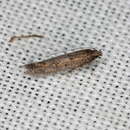en
names in breadcrumbs


Ephysteris is a genus of the twirler moth family (Gelechiidae). Among these, it is assigned to tribe Gnorimoschemini of the subfamily Gelechiinae. Even though it is a rather diverse and widespread group, most of these small and inconspicuous moths were overlooked by scientists until the early 20th century. Almost 90 species are known today but new ones are still being discovered.
These moths typically have forewing veins 2 and 3 separate but veins 6-8 originating from a common stalk. Somewhat less characteristically, their labial palps have a pointed tip and a furrow on the second segment.[2]
Ochrodia and Opacopsis were initially established as subgenera of Ephysteris but elevated to full genus status later. However, this is not universally accepted and both are included in the present genus here. Microcraspedus is another subgenus of Ephysteris, to which many of the European species are assigned; Echinoglossa is another. But before any of these can be accepted as subgenus or even distinct genus, the internal systematics of Ephysteris sensu lato are in need of review.[3]
The species of Ephysteris are:[4]
Ephysteris is a genus of the twirler moth family (Gelechiidae). Among these, it is assigned to tribe Gnorimoschemini of the subfamily Gelechiinae. Even though it is a rather diverse and widespread group, most of these small and inconspicuous moths were overlooked by scientists until the early 20th century. Almost 90 species are known today but new ones are still being discovered.
These moths typically have forewing veins 2 and 3 separate but veins 6-8 originating from a common stalk. Somewhat less characteristically, their labial palps have a pointed tip and a furrow on the second segment.
Ochrodia and Opacopsis were initially established as subgenera of Ephysteris but elevated to full genus status later. However, this is not universally accepted and both are included in the present genus here. Microcraspedus is another subgenus of Ephysteris, to which many of the European species are assigned; Echinoglossa is another. But before any of these can be accepted as subgenus or even distinct genus, the internal systematics of Ephysteris sensu lato are in need of review.